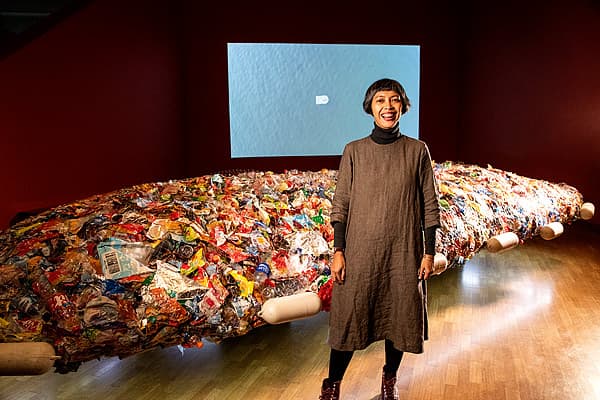Contemporary
worlds
Indonesia
Tita Salina
In Tita Salina’s practice, intervention, installation and moving image come together in response to site-specific issues that have global resonance. 1001st island – the most sustainable island in archipelago 2015 explores transnational issues of community disenfranchisement, environmental pollution and government corruption as they manifest within the Indonesian government’s grand plan for the restoration and redevelopment of Jakarta Bay.
Long plagued with a legion of environmental issues, Jakarta Bay and its environs are impacted by extreme pollution, the reduction of important fishing stocks, and rapid land sinkage due to groundwater extraction that provides drinking water for Jakarta’s 10 million inhabitants. Combined with the threat of rising sea levels, these problems jeopardise communities of small-scale fishermen and coastal traders who live on and around the bay. The government’s solution to the complex environmental and social issues is to build a giant sea wall across the bay to transform it into a man-made lagoon protected from flooding, populate it with new artificial islands, and redevelop the foreshore areas, moving existing coastal communities outside the city precincts. Many are sceptical about the efficacy of the plan and criticise it as scientifically dubious, socially discriminatory and financially irresponsible.
To create 1001st island, Salina collaborated with local fishermen from one of the threatened communities to collect some of the plastic rubbish that plagues the bay. Wrapped in a fishing net to construct an artificial island, it was then dragged behind a fishing boat into the bay and released to become the 1001st island in the chain of islands north of Jakarta known as the Thousand Islands. Ironically, due to plastic’s longevity and because it floats on water, the island is almost indestructible. The process was filmed by a drone camera from above and shows Salina standing or lying resolutely on the island, alone at sea.
The work is one of a series Salina is producing with fellow artist Irwan Ahmett through the platform The flame of the Pacific. Their aim is to explore and negotiate instability and tensions in the communities of the Pacific region and, through a performative platform, create an imaginary space where issues can be addressed. So far, the artists have built networks with local communities in 16 projects across Taiwan, China, Japan, Indonesia and New Zealand, and, through collaborative ‘everyday acts of social disobedience … intervened in the status quo through art’.1
Carol Cains
- About The flame of the Pacific’, at http://theflameofthepacific.com/about/, accessed 10 December 2018

Tita Salina
